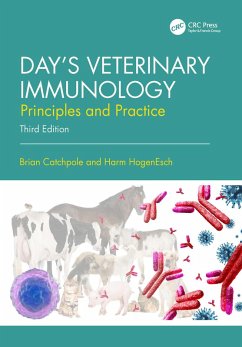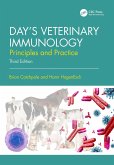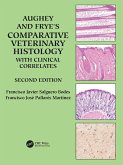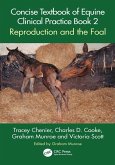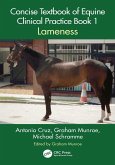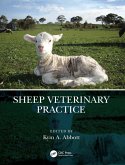

Alle Infos zum eBook verschenken

- Format: ePub
- Merkliste
- Auf die Merkliste
- Bewerten Bewerten
- Teilen
- Produkt teilen
- Produkterinnerung
- Produkterinnerung

Hier können Sie sich einloggen

Bitte loggen Sie sich zunächst in Ihr Kundenkonto ein oder registrieren Sie sich bei bücher.de, um das eBook-Abo tolino select nutzen zu können.
Michael Day's Veterinary Immunology: Principles and Practice is the adopted text in numerous veterinary schools throughout the world. Updated and revised by Brian Catchpole and Harm HogenEsch with advances in knowledge since 2014, this third edition reflects the rapid developments in the field internationally, while preserving the strengths of Day's original writing. It adds numerous case studies demonstrating the clinical context across companion and farm animals.
The textbook presents information on commonly used diagnostic test procedures and includes learning objectives at the start and…mehr
- Geräte: eReader
- mit Kopierschutz
- eBook Hilfe
![Day's Veterinary Immunology (eBook, PDF) Day's Veterinary Immunology (eBook, PDF)]() Brian CatchpoleDay's Veterinary Immunology (eBook, PDF)53,95 €
Brian CatchpoleDay's Veterinary Immunology (eBook, PDF)53,95 €![Aughey and Frye's Comparative Veterinary Histology with Clinical Correlates (eBook, ePUB) Aughey and Frye's Comparative Veterinary Histology with Clinical Correlates (eBook, ePUB)]() Francisco Javier Salguero BodesAughey and Frye's Comparative Veterinary Histology with Clinical Correlates (eBook, ePUB)57,95 €
Francisco Javier Salguero BodesAughey and Frye's Comparative Veterinary Histology with Clinical Correlates (eBook, ePUB)57,95 €![Concise Textbook of Equine Clinical Practice Book 2 (eBook, ePUB) Concise Textbook of Equine Clinical Practice Book 2 (eBook, ePUB)]() Tracey ChenierConcise Textbook of Equine Clinical Practice Book 2 (eBook, ePUB)59,95 €
Tracey ChenierConcise Textbook of Equine Clinical Practice Book 2 (eBook, ePUB)59,95 €![Concise Textbook of Equine Clinical Practice Book 1 (eBook, ePUB) Concise Textbook of Equine Clinical Practice Book 1 (eBook, ePUB)]() Antonio CruzConcise Textbook of Equine Clinical Practice Book 1 (eBook, ePUB)59,95 €
Antonio CruzConcise Textbook of Equine Clinical Practice Book 1 (eBook, ePUB)59,95 €![Sheep Veterinary Practice (eBook, ePUB) Sheep Veterinary Practice (eBook, ePUB)]() Sheep Veterinary Practice (eBook, ePUB)123,95 €
Sheep Veterinary Practice (eBook, ePUB)123,95 €![Emergency Care for Birds (eBook, ePUB) Emergency Care for Birds (eBook, ePUB)]() Rob van ZonEmergency Care for Birds (eBook, ePUB)53,95 €
Rob van ZonEmergency Care for Birds (eBook, ePUB)53,95 €![Pocket Handbook of Small Animal Medicine (eBook, ePUB) Pocket Handbook of Small Animal Medicine (eBook, ePUB)]() Kit SturgessPocket Handbook of Small Animal Medicine (eBook, ePUB)53,95 €
Kit SturgessPocket Handbook of Small Animal Medicine (eBook, ePUB)53,95 €-
-
-
The textbook presents information on commonly used diagnostic test procedures and includes learning objectives at the start and key points at the end of each chapter, standard symbols in diagrams throughout the text to provide continuity, clinical examples and clinicopathological figures throughout, and a glossary of terms and list of commonly used abbreviations. Short animations are viewable via the Support Materials tab on the Routledge webpage, adding a new element of practical application.
Exploring the immunological principles of both large and small animals, the book emphasizes immunological principles while applying them to disease processes and to clinical practice. It provides a practical textbook for veterinary students and a handy reference for practitioners.
Dieser Download kann aus rechtlichen Gründen nur mit Rechnungsadresse in A, B, BG, CY, CZ, D, DK, EW, E, FIN, F, GR, HR, H, IRL, I, LT, L, LR, M, NL, PL, P, R, S, SLO, SK ausgeliefert werden.
- Produktdetails
- Verlag: Taylor & Francis eBooks
- Seitenzahl: 432
- Erscheinungstermin: 31. Mai 2023
- Englisch
- ISBN-13: 9781000850734
- Artikelnr.: 67798872
- Verlag: Taylor & Francis eBooks
- Seitenzahl: 432
- Erscheinungstermin: 31. Mai 2023
- Englisch
- ISBN-13: 9781000850734
- Artikelnr.: 67798872
- Herstellerkennzeichnung Die Herstellerinformationen sind derzeit nicht verfügbar.
Harm HogenEsch is a Distinguished Professor of Immunopathology in the Department of Comparative Pathobiology of the Purdue University College of Veterinary Medicine. He received his DVM degree from the University of Utrecht, the Netherlands, and PhD in immunology from the University of Illinois at Urbana-Champaign. He is a Diplomate of the American College of Veterinary Pathologists. He worked for 3 years at the Institute for Aging and Vascular Research in Leiden, the Netherlands, before joining Purdue University. Harm's research interests include vaccine development and the immunopathology of allergic skin disease. He has published over 150 peer-reviewed articles and 22 book chapters. Harm teaches an immunology course for first year veterinary students and graduate students.
innate and adaptive immunity. Introduction. History of immunology. The
immune system: An overview. Principles of innate immunity. Principles of
adaptive immunity. Evolution of the immune system. Key points. Cells and
tissues of the immune system. Introduction. Haematopoesis and production of
white blood cells. Primary lymphoid tissues. Secondary lymphoid tissues.
The lymphatic system, lymphocyte recirculation and immune surveillance. Key
points. Innate immunity. Introduction. Defensive barriers.
Pattern-recognition receptors. Phagocytes and phagocytosis. Innate lymphoid
cells and natural killer cells. Lymphocytes with restricted diversity of
antigen receptors. The interferon response. The inflammatory response. The
acute phase response. Systemic inflammatory response syndrome. The
complement system. Key points. Lymphocyte development. Introduction.
Antigen recognition by lymphocytes. Development of B lymphocytes. T cell
development and maturation. Key points. The major histocompatibility
complex and antigen presentation. Introduction. The major
histocompatibility complex. MHC class I processing pathway. MHC class II
processing pathway. Antigen presentation by CD1 molecules to NKT cells.
Antigen presenting cells. Genetics and inheritance of the MHC. MHC
associations with immune function and disease. MHC and transplantation /
tissue graft rejection. Key points. Cytokines, chemokines and their
receptors. Introduction. Chemokines and chemokine receptors. Cytokines and
cytokine receptors. Key points. The biology of T lymphocytes.
Introduction. Chemokines and chemokine receptors. Cytokines and cytokine
receptors. Key points. Antibody structure and function. Introduction.
Antibody structure. Antibody binding to antigen. Biological properties of
antibody. Immunoglobulin classes. Key points. The biology of B lymphocytes.
Introduction. Antigen recognition by B cells. Activation of B lymphocytes.
The immunoglobulin class switch. Kinetics of the antibody response.
Monoclonal antibodies. Key points. Immunodiagnostics: Serology,
immunoassays and measurement of cell-mediated immunity. Introduction.
Serological tests and immunoassays. Immunophenotyping. Lymphocyte
stimulation assays. Tests of cytotoxic function. Tests of phagocytic cell
function. Key points. The immune response to infectious agents.
Introduction. The immune response to viral infection. The immune response
to bacterial infection. The immune response to helmith infection. The
immune response to protozoal infection. The immune response to fungal
infection. Key points. Immune evasion by pathogens. Introduction. Evading
the innate immune response. Evading the antibody-mediated adaptive immune
response. Evading the cell-mediated adaptive immune response.Specific viral
strategies for immune evasion. Key points. Vaccination. Introduction.
Passive immunization. Active immunization. Vaccine technologies. Vaccines
for non-infectious diseases. Vaccine adjuvants. Routes of administering
vaccines. Basic principles of vaccination. Vaccination failure. Adverse
consequences of vaccination. Key points. Immune system ontogeny and
neonatal immunology. Introduction. Immune system ontogeny. Passive transfer
of maternal immune protection. Neonatal vaccination. Failure of passive
transfer. Neonatal isoerythrolysis. Early life immune development. Key
points. Immunological tolerance and immune suppression. Introduction.
Tolerance and tolerance mechanisms. Central tolerance. Peripheral
tolerance. Mucosal tolerance. Fetomaternal and neonatal tolerance.
Antibody-mediated suppression. The neuroendocrine-immunological loop. Key
points. Immunodeficiency. Introduction. Primary immunodeficiency. Secondary
immunodeficiency. Key points. Hypersensitivity reactions. Introduction. The
Gell and Coombs classification of hypersensitivity. Type I
hypersensitivity. Type II hypersensitivity. Type III hypersensitivity. Type
IV hypersensitivity. Key points. Hypersensitivity disorders and allergic
disease. Introduction. Factors predisposing to allergic disease. Systemic
allergic reactions. Allergic skin disease. Respiratory disease.
Gastrointestinal disease. Diagnosis of allergic disease. Key points.
Autoimmunity and autoimmune disease. Introduction. The genetic basis for
autoimmunity. Intrinsic / host factors in susceptibility to autoimmune
disease. Extrinsic / environmental factors in susceptibility to
autoimmunity. Autoimmune diseases mediated by autoantibodies. Autoimmune
diseases mediated by autoreactive T cells. Diagnostic tests for autoimmune
disease. Key points. Cancer immunology and immune system neoplasia.
Introduction. Tumour antigens. The anti-tumour immune response.
Tumour-promoting immune activity. Immune evasion by tumours. Immunotherapy
to enhance the anti-tumour immune response. Tumours of the immune system.
Key points. Immunotherapy. Introduction. Immunosuppressive agents. Janus
kinase inhibitors. Intravenous immunoglobulin therapy. Allergen-specific
immunotherapy. Monoclonal antibody therapy. Cytokine therapy.
Immunostimulatory agents. Key points. Case studies in clinical immunology.
innate and adaptive immunity. Introduction. History of immunology. The
immune system: An overview. Principles of innate immunity. Principles of
adaptive immunity. Evolution of the immune system. Key points. Cells and
tissues of the immune system. Introduction. Haematopoesis and production of
white blood cells. Primary lymphoid tissues. Secondary lymphoid tissues.
The lymphatic system, lymphocyte recirculation and immune surveillance. Key
points. Innate immunity. Introduction. Defensive barriers.
Pattern-recognition receptors. Phagocytes and phagocytosis. Innate lymphoid
cells and natural killer cells. Lymphocytes with restricted diversity of
antigen receptors. The interferon response. The inflammatory response. The
acute phase response. Systemic inflammatory response syndrome. The
complement system. Key points. Lymphocyte development. Introduction.
Antigen recognition by lymphocytes. Development of B lymphocytes. T cell
development and maturation. Key points. The major histocompatibility
complex and antigen presentation. Introduction. The major
histocompatibility complex. MHC class I processing pathway. MHC class II
processing pathway. Antigen presentation by CD1 molecules to NKT cells.
Antigen presenting cells. Genetics and inheritance of the MHC. MHC
associations with immune function and disease. MHC and transplantation /
tissue graft rejection. Key points. Cytokines, chemokines and their
receptors. Introduction. Chemokines and chemokine receptors. Cytokines and
cytokine receptors. Key points. The biology of T lymphocytes.
Introduction. Chemokines and chemokine receptors. Cytokines and cytokine
receptors. Key points. Antibody structure and function. Introduction.
Antibody structure. Antibody binding to antigen. Biological properties of
antibody. Immunoglobulin classes. Key points. The biology of B lymphocytes.
Introduction. Antigen recognition by B cells. Activation of B lymphocytes.
The immunoglobulin class switch. Kinetics of the antibody response.
Monoclonal antibodies. Key points. Immunodiagnostics: Serology,
immunoassays and measurement of cell-mediated immunity. Introduction.
Serological tests and immunoassays. Immunophenotyping. Lymphocyte
stimulation assays. Tests of cytotoxic function. Tests of phagocytic cell
function. Key points. The immune response to infectious agents.
Introduction. The immune response to viral infection. The immune response
to bacterial infection. The immune response to helmith infection. The
immune response to protozoal infection. The immune response to fungal
infection. Key points. Immune evasion by pathogens. Introduction. Evading
the innate immune response. Evading the antibody-mediated adaptive immune
response. Evading the cell-mediated adaptive immune response.Specific viral
strategies for immune evasion. Key points. Vaccination. Introduction.
Passive immunization. Active immunization. Vaccine technologies. Vaccines
for non-infectious diseases. Vaccine adjuvants. Routes of administering
vaccines. Basic principles of vaccination. Vaccination failure. Adverse
consequences of vaccination. Key points. Immune system ontogeny and
neonatal immunology. Introduction. Immune system ontogeny. Passive transfer
of maternal immune protection. Neonatal vaccination. Failure of passive
transfer. Neonatal isoerythrolysis. Early life immune development. Key
points. Immunological tolerance and immune suppression. Introduction.
Tolerance and tolerance mechanisms. Central tolerance. Peripheral
tolerance. Mucosal tolerance. Fetomaternal and neonatal tolerance.
Antibody-mediated suppression. The neuroendocrine-immunological loop. Key
points. Immunodeficiency. Introduction. Primary immunodeficiency. Secondary
immunodeficiency. Key points. Hypersensitivity reactions. Introduction. The
Gell and Coombs classification of hypersensitivity. Type I
hypersensitivity. Type II hypersensitivity. Type III hypersensitivity. Type
IV hypersensitivity. Key points. Hypersensitivity disorders and allergic
disease. Introduction. Factors predisposing to allergic disease. Systemic
allergic reactions. Allergic skin disease. Respiratory disease.
Gastrointestinal disease. Diagnosis of allergic disease. Key points.
Autoimmunity and autoimmune disease. Introduction. The genetic basis for
autoimmunity. Intrinsic / host factors in susceptibility to autoimmune
disease. Extrinsic / environmental factors in susceptibility to
autoimmunity. Autoimmune diseases mediated by autoantibodies. Autoimmune
diseases mediated by autoreactive T cells. Diagnostic tests for autoimmune
disease. Key points. Cancer immunology and immune system neoplasia.
Introduction. Tumour antigens. The anti-tumour immune response.
Tumour-promoting immune activity. Immune evasion by tumours. Immunotherapy
to enhance the anti-tumour immune response. Tumours of the immune system.
Key points. Immunotherapy. Introduction. Immunosuppressive agents. Janus
kinase inhibitors. Intravenous immunoglobulin therapy. Allergen-specific
immunotherapy. Monoclonal antibody therapy. Cytokine therapy.
Immunostimulatory agents. Key points. Case studies in clinical immunology.
